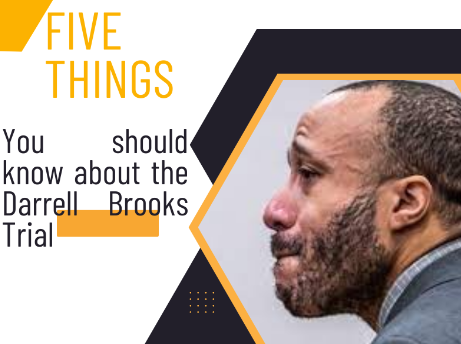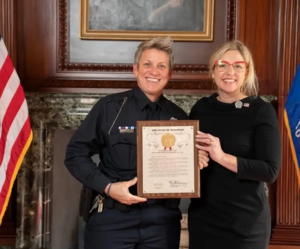5 Things You Should Know About the Darrell Brook Trial

December 5, 2022
1. Darrell brooks was found guilty
After three hours of deliberation by the jury, Brooks was charged with 76 criminal charges, which includes 6 counts of 1st degree intentional homicide, after Darrell Brooks drove his SUV through the Waukesha Christmas parade. After being found guilty, a Sentencing took place on November 15th and 16th, where Brooks’ was sentenced to 6 consecutive life sentences without the chance for parole plus an additional 700 years. The sentencing trial took place over the course of two days, where both sides of the case had a chance to read statements to the court. Mr. Brooks’ spoke for two hours claiming there was a recall on the vehicle, but Judge Dorrow struck this statement from the record. After Brooks’ sentencing trial, he will have 20 days to file a notice to appeal.
“Appeals are essentially a request to undo the result of a case based on some gigantic error that occurred during the case.” Said defense attorney Paul Rifelj. “If you look at some famous examples, (like the case of Adnan Syed in Maryland) you will also see that appeals take a lot of time, years, to complete.”
At this time, Darrell Brooks has stated that he plans to appeal the court’s decision.
2. Darrell Brooks represented himself
In late September, nearing the beginning of his trial, Brooks dismissed his legal team and filed a motion to represent himself. Judge Jennifer Dorrow approved this motion, stating that Brooks understands the disadvantages of self-representation and will be proceeding without counsel.
“Informed of,” said Brooks. “I never said I understand. I never once said I understand. As a matter of fact I do not understand.”
Brooks was given time to think over the decision of giving up his right to counsel, and ultimately decided to go the self representation route.
“When a criminal defendant chooses self representation, it dramatically alters the course of a trial. When a non-attorney decides to litigate for themselves, it opens the door to missteps and errors that never would have occurred if an attorney was doing the trial.” Said Attorney Paul Rifelj.
“An attorney, knowing that there is no way the information could come in at trial, would not bring that information up in front of the jury. A non-attorney may bring it up, unaware that the information is improper. It gets even worse if the improper information could be prejudicial to the jury.”
Brooks’ was provided with some basic tools to assist him in the trial, such as guidelines for how to write a closing statement, but gave up his right to professional assistance from an Attorney.
“I’ve seen self representation before, but never in a felony case. We see it on a lot of low level crimes like smaller misdemeanors and traffic offenses, but felonies it’s very very rare to see someone representing themselves.” Said Waukesha District Attorney Sue Opper.
While it is true that self representation put Brooks’ at a disadvantage, it has been said by many people that Darrell Brooks is actually very intelligent, and was capable of understanding the bigger topics discussed at the trial despite his lack of legal training.
3. There was high media presence
Throughout the 3 ½ week trial, there were swarms of reporters hoping to get new information about what was happening within the courtroom. But for those who were hoping to watch the trial on their own time, many major news sites were live streaming the trial such as CourtTv, tmj4, and the Law & Crime network. There was question as to if this media presence could have impacted Darrell Brooks behavior, and contributed to the aggravating factors involved in any trial.
“It’s not like the cameras are in your face like a reality TV show, they are so hidden you barely even notice them.” Said Sue Opper. “It can seem like the cameras are everywhere and catching every move, but they are actually quite far away from us.”
The high media coverage of this trial was enhanced by this case going viral on many social media platforms, especially TikTok, which is largely responsible for this already popular case spreading throughout the country. One video that went viral, collecting over 419.2Million views was titled “Darrell Brooks time out”, featuring the many times Judge Dorrow removed Brooks’ from the courtroom.
4. Darrell Brooks is facing charges in Milwaukee
In early November of 2021, a few weeks before the Waukesha Christmas Parade, Brooks was charged with two felonies and three misdemeanors after allegedly running over his girlfriend in a Milwaukee gas station parking lot. This was done in the same car that Brooks would later drive through the parade, leaving Brooks’ girlfriend with a bloody face and tire marks on her leg. Brooks’ then later tried to persuade the woman to not cooperate with investigators in exchange for marriage, which would earn him three more felonies including intimidating a witness.
5. There were many outbursts and disruptions
A thing to note about the trial was the frequency of outbursts from the defendant, Darrell Brooks. Mr. Brooks’ frequent disruptions led to him being removed to the adjacent court room on multiple occasions, watching the trial virtually until being allowed by Judge Dorrow to return to the main courtroom. The jury was also removed on multiple occasions so that Judge Dorrow could correct Mr. Brooks’ behavior without the presence of a jury.
“I would say that myself, the other prosecutors, and the judge got used to the disruptions. The first couple days it was like you couldn’t finish a thought in your brain without Mr. Brooks objecting or trying to raise a different issue. It wasn’t conversational like it should be because everybody would kind of wait, see what he was gonna do, and then start speaking. It was very disruptive, and a tactic on his part for sure.” Said Waukesha District Attorney Sue Opper.













